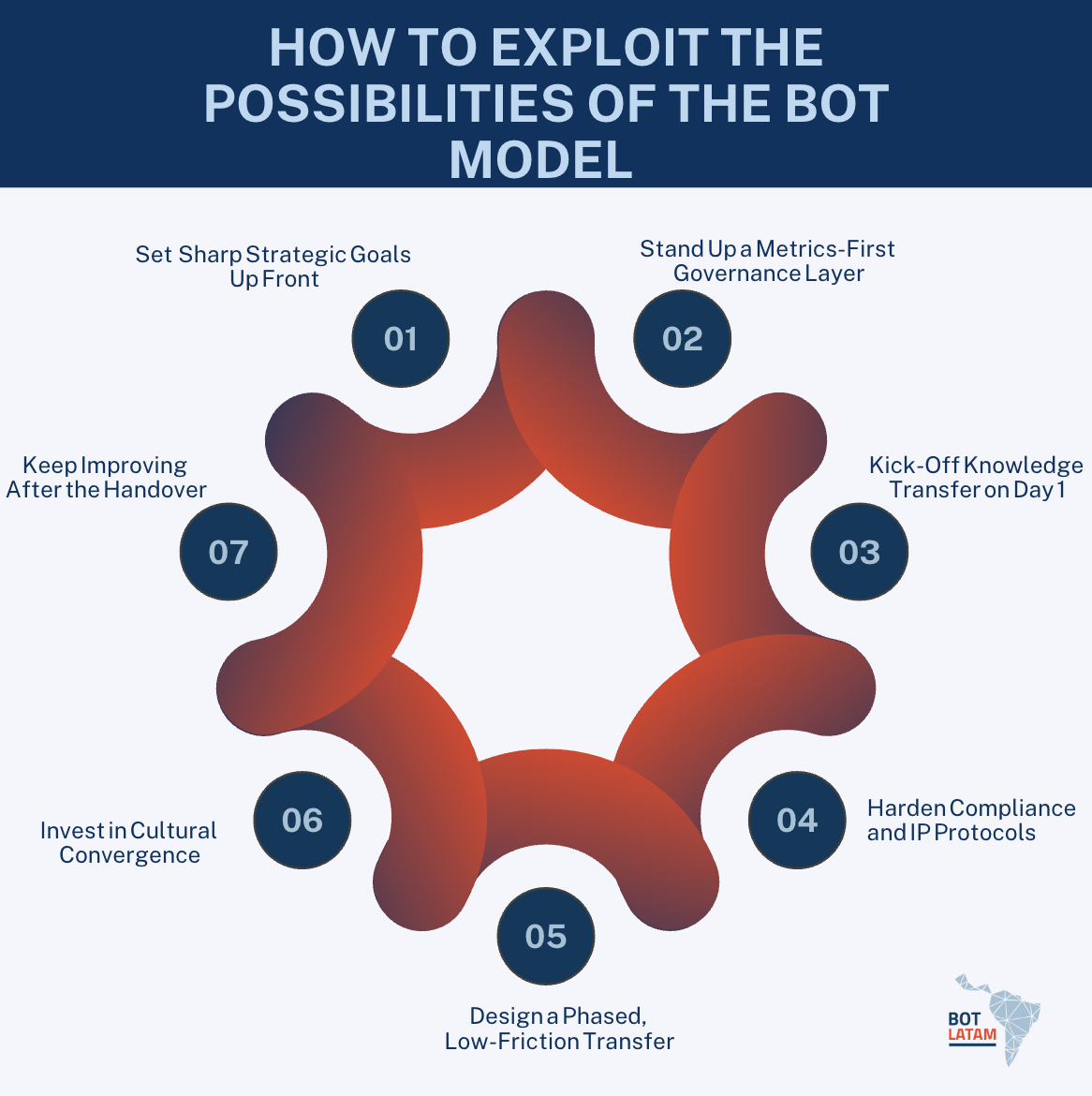Choosing the right nearshore model for LATAM can make or break your expansion strategy. With growing pressure to reduce costs and access specialized talent, U.S. companies are turning to Latin America more than ever. But not all nearshoring models offer the same flexibility, control, or ROI.
One option gaining traction is the Build-Operate-Transfer (BOT) model. It allows businesses to scale quickly with local infrastructure and talent, without committing to long-term operational burdens up front. In fact, nearshoring to LATAM cut operational costs by up to 40% for U.S. firms, according to NASSCOM.
This article breaks down what the BOT model really offers, how it stacks up against other popular LATAM nearshore models, and when it’s the smartest option for your team. You’ll get practical insights, side-by-side comparisons, and a clear framework to decide if BOT is the best fit for your needs. Keep reading to learn more!
What Makes BOT a Great Nearshore Option
Rapid Ramp‑Up Without Long‑Term Risk.
Launching a captive team from scratch can take quarters. A BOT partner already holds the legal entity, leases the office (or manages remote payroll), and knows where to source equipment. That pre-built infrastructure routinely trims 20–30% off the typical setup timeline, according to Deloitte’s Global Shared Services and Outsourcing Survey. You get speed now and, crucially, the option to walk away if the model stops serving you.
Significant Labor Savings and Predictable Costs.
Latin American nearshore centers deliver a 20–40% labor arbitrage for more than half of U.S. companies, while 18% report savings above 40%, based on findings from the Accelerance 2023 Global Software Outsourcing Trends and Rates Guide. Because the BOT contract locks in salaries and overhead for the Operate phase, you avoid the cost creep that often hits staff augmentation models.
Real-Time Collaboration, Minimal Jet Lag.
Most major LATAM tech hubs, like Bogotá, São Paulo, and Mexico City, are within one to two hours of Eastern Standard Time. That proximity enables real-time collaboration, which reduces delivery delays and enhances agile practices. In fact, a McKinsey report found that nearshore teams operating in aligned time zones shortened product delivery cycles by up to 25%.
Built-In Compliance and IP Protection.
During the build and operate phases, your BOT partner handles payroll, taxes, and compliance with local data laws. Once the operation transfers, you receive a legally compliant and audit-ready entity. A study by ISG (Information Services Group) reported that structured nearshore models like BOT reduce performance and compliance risks by up to 30% compared to traditional outsourcing.
Seamless Knowledge Transfer and Future Ownership.
BOT contracts include a defined transition period, usually 90 to 120 days, for moving SOPs, repositories, tools, and vendor relationships in-house. This formal handover avoids the vendor lock-in that often slows down innovation. The World Bank’s Private Sector Infrastructure Guidelines also highlight BOT’s transfer phase as a risk-mitigation mechanism that ensures long-term control.
Scalable Access to LATAM’s Expanding Talent Pool.
Brazil and Argentina collectively graduate over 500,000 IT professionals annually, according to the Inter-American Development Bank (IDB). With the BOT model, you gain early access to that talent while maintaining the option to scale headcount up or down depending on roadmap priorities, without having to renegotiate a rigid SOW.
Transparent, Metric-Driven Operations.
The BOT model builds KPIs, like sprint velocity, defect rates, and on-time release percentages, into the operation phase from day one. You get performance dashboards, not just vague reporting. According to KPMG’s Global IT-BPO Outsourcing Deals Analysis, this transparency boosts stakeholder confidence and improves governance outcomes across cross-border teams.
Together, these elements explain why BOT consistently ranks as the most flexible, risk-balanced nearshore model for companies evaluating options across LATAM. It’s not just about cost, it's about long-term ownership, stability, and visibility.
Advantages of BOT Against Other Models
More Control Than Staff Augmentation:
With staff augmentation, vendors supply the talent, but you rarely own the process. There’s limited influence over recruitment pipelines, training standards, or delivery quality. BOT changes that. You co-design the team from day one, shaping workflows, tooling, and governance structures to match your standards. Once transferred, full operational control is yours.
That level of ownership is a major reason why 64% of IT leaders cite “control over resources” as a top priority when transitioning from traditional outsourcing to hybrid or BOT models.
More Flexibility Than Dedicated Teams:
Dedicated development teams offer continuity and focus but often lack strategic scalability. When you need to pivot, new stack, new product line, regional expansion, dedicated models can slow you down with locked-in roles and vendor-managed operations.
In contrast, BOT evolves with your roadmap. You define the org chart, scale headcount based on sprint velocity or product releases, and make leadership changes midstream. You’re not tied to rigid team structures.
Better ROI Than Managed Services:
Managed services provide predictable outcomes, but at a price. Vendors bake in premiums to cover their risk, which can drive total cost of ownership 15–30% higher over a three-year term, according to ISG Outsourcing Index. Plus, any intellectual property developed typically remains under vendor custody.
BOT keeps your cost structure lean during the Operate phase. And once you take over, you hold 100% of the IP, infrastructure, and talent assets. That’s a better return on long-term investment compared to high-margin service contracts.
Lower Risk Than Captive Centers:
Setting up a captive center in LATAM is capital-intensive and loaded with regulatory risk. From entity registration to labor law compliance, the process can take up to 12 months, depending on the country, according to PwC LATAM Investment Guide.
BOT eliminates that barrier to entry. Your partner handles all legal and operational setup. You inherit a proven, functioning operation once the transfer is complete, without the regulatory exposure of going in alone.
Built-In Exit Strategy:
Few outsourcing models offer a clean off-ramp. Staff aug and managed service contracts typically include early termination penalties or IP transfer fees. With BOT, the end state is predefined. After the transfer, your dependency on the vendor ends.
According to McKinsey, structured exit options reduce vendor lock-in risks by over 40%, a key advantage for companies seeking operational autonomy without long-term obligations.
These differences position BOT as a more adaptable, cost-aware, and scalable alternative to traditional nearshoring models, especially when building product teams in LATAM.
How To Exploit The Possibilities of The BOT Model

1. Set Sharp Strategic Goals Up Front:
Treat the build phase as a sprint toward clearly defined outcomes, team size, tech stack, and delivery KPIs, not a loose discovery period. Deloitte’s 2024 Global Outsourcing Survey shows that 70 percent of executives now bring formerly outsourced scope back in‑house to regain strategic control, a trend the BOT framework accelerates by design. Agree on success metrics before signing, then bake them into the master services agreement.
2. Stand Up a Metrics‑First Governance Layer:
Dashboards beat status emails. BOT teams that embed standardized project‑management practices hit their scope, schedule, and budget targets at a rate seven times higher than peers, according to PMI’s Pulse of the Profession study (86 percent vs 12 percent) pmi.org. From day one, capture sprint velocity, defect leakage, and cost per feature behind a single pane of glass so finance, engineering, and vendors operate from the same data.
3. Kick‑Off Knowledge Transfer on Day 1:
Don’t wait for the transfer phase to document tribal know‑how. PMI reports that 70 percent of successful change programs involve stakeholders early and often, pmi.org. Record architecture decisions, workflow playbooks, and environment scripts as you build; automate hand‑offs with CI/CD pipelines. Early transfer prep keeps the final cut‑over from turning into a rewrite marathon.
4. Harden Compliance and IP Protocols:
Regulation in tech is rising fast, as 84 percent of chief compliance officers expect tougher scrutiny within two years, KPMG. Map local labor, data‑privacy, and tax rules to each BOT phase, and insist on escrowed source code plus dual‑factor repository access. You’ll exit the Operate phase with an audit‑ready entity instead of a red‑flag list.
5. Design a Phased, Low‑Friction Transfer:
Break the handover into logical increments, core services, extensions, then ops tooling, so nothing critical slips. Case studies show that staged transfers cut post‑go‑live incident volume by 30–40 percent compared with “big‑bang” exits, pmi.org. Pair every vendor lead with an internal counterpart, run dry‑run cut‑overs in a staging environment, and verify SLAs on each slice before signing off.
6. Invest in Cultural Convergence:
Shared office hours beat midnight stand‑ups. Leverage LATAM’s one‑ to two‑hour time‑zone overlap with U.S. business hours to keep design reviews and backlog grooming synchronous. Pulse surveys routinely rank real‑time collaboration above wage savings as the top driver of nearshore satisfaction, Sonatafy Technology. Rotate product owners through the LATAM site and sponsor English‑Spanish lunch‑and‑learns to cement rapport.
7. Keep Improving After the Handover:
A BOT isn’t “set it and forget it.” Once the entity is yours, benchmark its cost base against third‑party managed‑services rates; Everest Research found outsourced operations run 5‑15 percent cheaper than poorly optimized captives' CIO. Use those numbers to drive Kaizen projects, automate routine QA, refactor legacy modules, and revisit vendor contracts to lock in the long‑term ROI.
Ready to Implement the Best Nearshore Model for LATAM?
The BOT model isn’t just another outsourcing framework; it’s a path to operational autonomy, lower risk, and long-term value creation. When implemented strategically, BOT allows companies to build nearshore operations that feel local without assuming the overhead or exposure on day one. In LATAM, where tech talent is abundant and regulatory nuances vary by country, structure and local expertise matter.
At BOT LATAM, we specialize in full-cycle Build Operate Transfer models tailored for high-growth U.S. and EU tech companies expanding into Latin America. Our team combines regional legal and HR infrastructure with deep delivery experience to minimize time-to-value while protecting your long-term IP and operational control.
We’ve seen firsthand how BOT succeeds when built on transparency, compliance-first planning, and local execution. If you're evaluating nearshoring options, we can help design a custom BOT engagement that aligns with your roadmap, risk profile, and growth strategy. Contact us to schedule a free discovery call and get started now!

Revolutionize Your Workflow with Our Innovative BOT Strategy!
Enhance your operations seamlessly and adapt to market demands
Contact Us


%2016.01.18.png)
.jpg)
